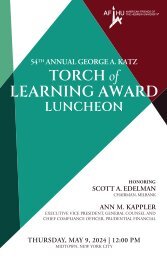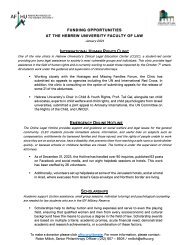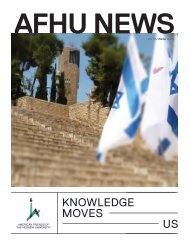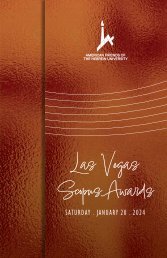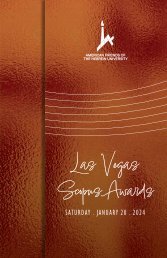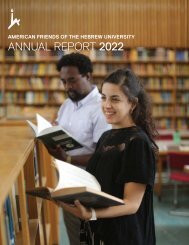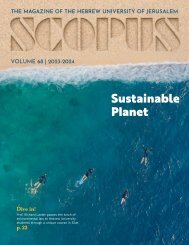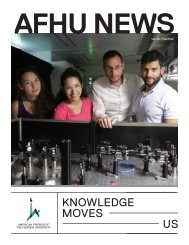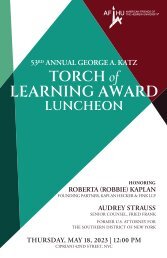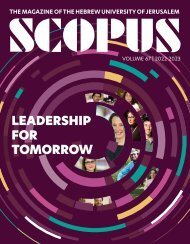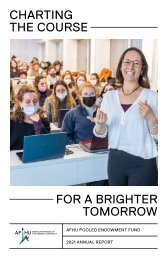Create successful ePaper yourself
Turn your PDF publications into a flip-book with our unique Google optimized e-Paper software.
ia<br />
l n o s<br />
How does one eat a popsicle? Why does white skin get red<br />
and peel when exposed to the sun? How come Jews in<br />
Israel don’t smash all their dishes before Passover? These<br />
are a few of the questions OYP student Rachel Friedberg<br />
and OY'P graduate Daniel Gordon dealt with over<br />
Passover. Rachel and Daniel are two of the 13 students<br />
whom the Office of Student Activities and the Youth Aliya<br />
Department chose to help Ethiopian youth,aged 11-18,for<br />
eleven days in special villages around Israel.<br />
Rachel and Daniel were sent to Hofim, which they feel<br />
is “the best and biggest youth village.” They spent most of<br />
their time taking the 200 Ethiopian children, who usually<br />
traveled with a canteen in one hand and a school book in<br />
thè other, to their Passover tiyulim in the Galil. “The kids<br />
were amazing!” recalls Rachel. “Most of them would be<br />
completely justified if they spent all their time weeping and<br />
moaning, but I never heard them complain. Although a few<br />
have parents living in absorption centers, most of the<br />
children will never see their mothers or fathers again, either<br />
because they are stranded in Ethiopia or are dead. Some of<br />
the children have physical scars from their 300-kilometer<br />
desert treks from Ethiopia to Sudanese refugee camps.<br />
Other children have mental scars from watching their<br />
parents and siblings die from starvation and illness. But<br />
they all manage to stay cheerful.<br />
Arriving at Hofim on April 4, the 5 OYP volunteers<br />
came just in time to help celebrate the young Ethiopians<br />
first Passover in Israel. Although the staff was anxious to<br />
teach the kids new customs, they were careful. They did<br />
not want to repeat the policy of 30 years ago that many<br />
sociologists believe was a deliberate attempt by the Israeli<br />
government to eliminate the language and culture of the<br />
Oriental Jewish immigrants. The night before and during<br />
the Seder, father figure and village coordinator Rabbi<br />
Nachum Cohen explained to the children the reasons<br />
behind the Israeli rituals and prayers. When possible,<br />
traditions of both cultures were honored. For example, a<br />
half-Hebrew, half-Amharic Hagaddah was used. Both Israeli<br />
and Ethiopian songs were sung. And, after the traditional<br />
reading of the Hagaddah, an 11-year-old boy stood up and<br />
chanted from memory in the holy language of Baez for over<br />
20 minutes. His father was a kohen (priest) in his village.<br />
Although the service was stretched out to over four hours,<br />
“.The children stood completely still,” recalls Darnel.<br />
The only thing the staff might have done wrong, say<br />
Daniel and Rachel, was that in teaching the children they<br />
implied that all Israeli Jews keep these customs. The youth<br />
are sheltered from the fact that most Israelis do not observe<br />
Jewish law. “They might get a big shock when they see<br />
Israeli society,” states Daniel. Adds Rachel, "The girls<br />
wouldn’t understand that I usually don’t wear a skirt.”<br />
Most of the kids will learn Hebrew and basic Judaism<br />
at the village for another six months. After that, they will<br />
be sent to special boarding schools. Most hope to go on to<br />
University one day, except for a few who, Daniel points<br />
out, “would prefer to become soccer stars.”<br />
BECCA LEVY<br />
Newton, Mass.<br />
84




